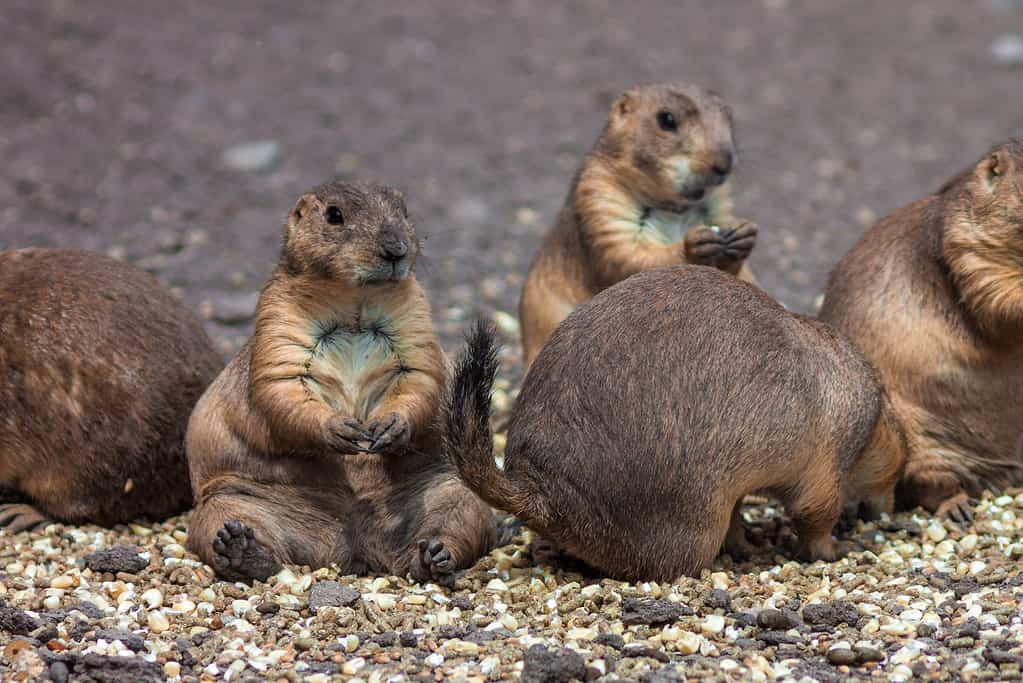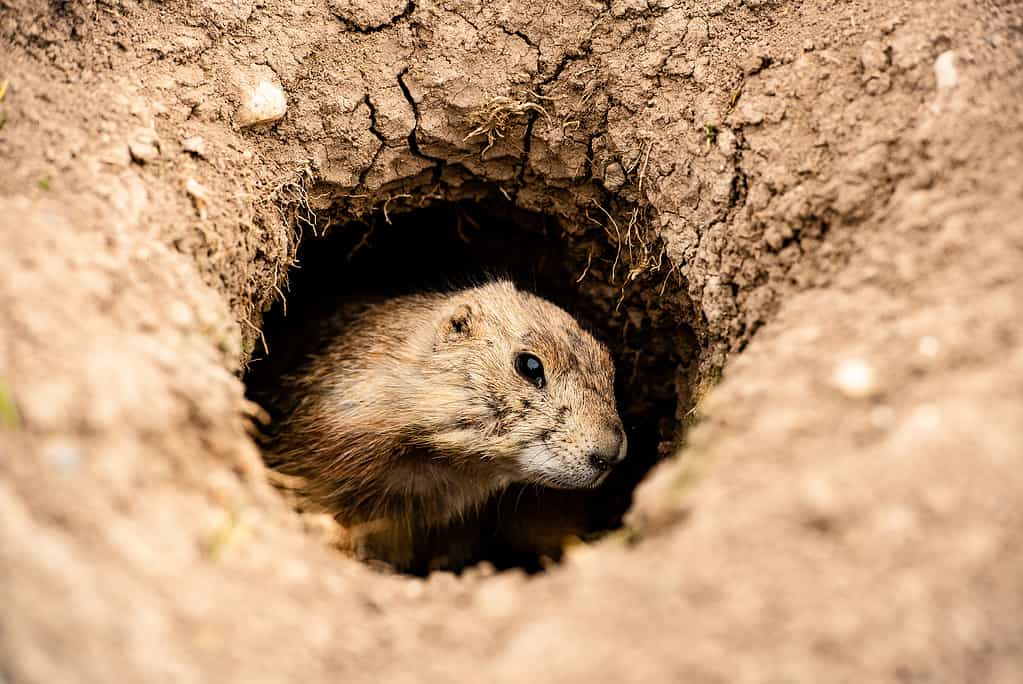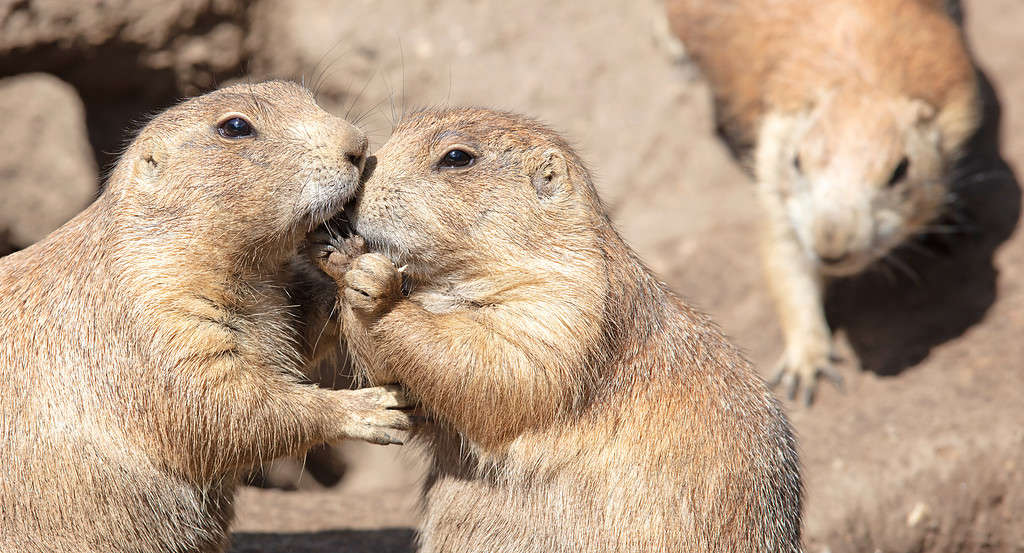Do prairie dogs make good pets? Looking at their adorable little faces, you’d think it’s a slam-dunk. But the truth is that prairie dogs, like any other animal, have specific needs that a caring and capable pet owner must meet. If you’re considering bringing home a prairie dog as a companion, you’ll want to know how to keep them happy and healthy. Read on to discover the pros and cons of prairie dog ownership and what you can do to help your little friend thrive!
What Are Prairie Dogs?

Prairie dogs come in five different species, including the Mexican prairie dog.
©Alberto Cavazos/Shutterstock.com
Prairie dogs are any of five species of herbivorous burrowing ground squirrels in the genus Cynomys. These rodents are native to the grasslands of North America. The most common species of pet prairie dog is the black-tailed prairie dog (Cynomys ludovicianus). The other four species are:
- Gunnison’s prairie dog (Cynomys gunnisoni)
- Mexican prairie dog (Cynomys mexicanus)
- Utah prairie dog (Cynomys parvidens)
- White-tailed prairie dog (Cynomys leucurus)
Do Prairie Dogs Make Good Pets?
Prairie dogs make good pets for those prepared to care for them. Everyone’s situation and tolerance for pet care is different. Check out the pros and cons of prairie dog ownership to get a feel for whether or not it’s right for you.
Do Prairie Dogs Make Good Pets?: Pros
Here are a few pros of prairie dog ownership:
- They’re fairly long-lived. This is a definite pro for pet owners who want a long-lived pet. The typical lifespan of a captive prairie dog in good health is between eight and 10 years, which is longer than that of many other rodents.
- They’re diurnal. Unlike some rodents, prairie dogs are diurnal, which means they are active during the day and sleep at night.
- They’re affectionate. Prairie dogs make very affectionate pets when appropriately socialized. They love interaction with humans or other prairie dogs and are always willing to engage.
- They don’t need to be walked. Although some prairie dogs may enjoy walking with you outdoors (and yes, leashes are made specifically for them), they don’t require that kind of exercise. They should be perfectly happy as long as they have sufficient space to move around and burrow in their enclosure and sometimes outside their pen.
Do Prairie Dogs Make Good Pets?: Cons

Prairie dogs need lots of space to move and burrow.
©Brandi Lyon Photography/iStock via Getty Images
Here are a few cons of prairie dog ownership:
- They’re fairly long-lived. Although this is a pro for some people, others don’t want the responsibility of long-term pet care. If you bring home a young prairie dog, you should prepare for up to a decade of ownership.
- They require considerable care. Prairie dogs are not one of those pets you can feed occasionally and then leave to themselves. They need a lot of care and attention to thrive. This includes near-constant socialization with their owners and – ideally – other prairie dogs. You can find more information about their needs in the next section, “Caring for a Prairie Dog.”
- They need a lot of space to move and burrow. Prairie dogs need large cages or enclosures to be happy and healthy, including places to burrow and hide. If they don’t get this, they’re likely to develop health issues like anxiety.
- They can be aggressive if not properly socialized. Like any pet, prairie dogs need proper socialization to bring out their best traits. Unsocialized or neglected prairie dogs, including their human owners, frequently exhibit aggressive tendencies toward others. They may also be nippy with children who don’t know how to handle them.
- Their teeth never stop growing. Because their teeth keep growing throughout their lives, prairie dogs need to constantly chew objects to wear them down. This means they occasionally chew things you don’t want destroyed.
- Owning a prairie dog is illegal in some states. For various reasons, some U.S. states ban pet prairie dogs. Check your state’s or country’s regulations before acquiring a prairie dog. Also, remember that if you decide to move from one state to another, you may not be able to bring your pet.
Caring for a Prairie Dog
Prairie dogs require considerable care and attention. Be sure you can provide the following before bringing a prairie dog home with you:
Food and Water
Try to feed your pet prairie dog a diet that mimics their natural diet in the wild. Prairie dogs are vegetarians, so don’t include any meat products. In the wild, they mostly eat grasses, brush, and roots. Prickly pear cactus gives them much of their water intake. Captive prairie dogs rely on high-fiber pellets, fresh hay and grasses (including timothy hay or timothy hay cubes), fresh fruits, and fresh vegetables like raw sweet potatoes and carrots. Make sure to provide them with plenty of fresh water. Avoid feeding them foods that can make them obese like nuts, dried fruit, other sugary foods, and dog food. Prairie dogs should have access to food and water around the clock as they are grazers.
Housing
Above all, prairie dogs need sufficient space to move around and plenty of hiding places where they can burrow out of sight. Keeping them in a cage without dirt to burrow in or anywhere to hide is likely to cause anxiety and anxiety-induced issues from too much stimulus.
The more prairie dogs you have, the bigger the enclosure needs to be. Make sure to clean the enclosure out at least once a week to maintain a hygienic environment. Also, remember that prairie dogs are adept at escaping inadequate enclosures, so only purchase housing specifically designed or approved for prairie dogs.
Prairie dogs can survive a wide range of temperatures as long as they have somewhere to burrow. For this reason, you can keep them either inside or outside. However, their preferred temperature is around 70°F.
Companionship

Prairie dogs are extremely sociable animals that need near-constant companionship.
©MyImages_Micha/iStock via Getty Images
Prairie dogs are highly sociable animals in the wild that spend most of their time with other prairie dogs. They need the same kind of frequent socialization in captivity to be happy and healthy. It’s best to keep more than one prairie dog at a time to ensure they get enough companionship. If you’re able to spend a significant amount of time with your pet, you may be able to keep just one.
If you plan to house males together, neutering them all first to prevent unwanted aggression is wise. Females should be good to live with both males and other females with or without being spayed. However, if you don’t want the females getting pregnant, it’s best to either spay them or neuter any males with whom they share housing.
Exercise
While you don’t need to walk your prairie dog, it will require some form of exercise. An exercise wheel in the enclosure is a great way to keep your pet active and stave off boredom. Time out of the enclosure is also important to give it the chance to roam about more freely.
Health and Reproductive Care

Spay or neuter your pet prairie dog to prevent unwanted litters of pups.
©iStock.com/HenkBentlage
Like other pets, prairie dogs require regular health care, including vaccinations. One of the most common problems associated with these small rodents is dental disease. Always provide them with something safe to chew on to help prevent dental issues.
Spaying and neutering your prairie dogs can prevent a slew of health problems and unwanted pregnancies down the road. Although most females only get pregnant once a year, they have litters of between 2 and 10 pups. Pregnant or nursing females may also display aggression toward other prairie dogs or their human owners. For this reason, you should keep them in a separate enclosure. If you do find yourself with a litter of pups on your hands, be sure to provide them with ample space to grow and develop.
Do Prairie Dogs Make Good Pets?: Summary Table of Pros and Cons
| Pros | Cons |
|---|---|
| Long-lived (8-10 years) | Long-lived (8-10 years) |
| Diurnal | Need considerable care |
| Affectionate | Need a lot of space to move and burrow |
| Don’t need to be walked | Can be aggressive if not socialized |
| Constant chewers | |
| Illegal in some states |
Conclusion
Prairie dogs make good pets for people committed to caring for them. These rodents are friendly, affectionate animals as long as their owners socialize them properly. Be sure to buy prairie dogs from a reputable, ethical breeder to avoid unnecessary health problems.
The photo featured at the top of this post is © Henk Bentlage/iStock via Getty Images
Thank you for reading! Have some feedback for us? Contact the AZ Animals editorial team.






